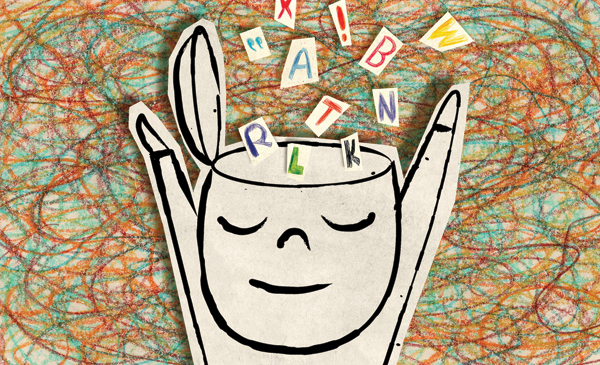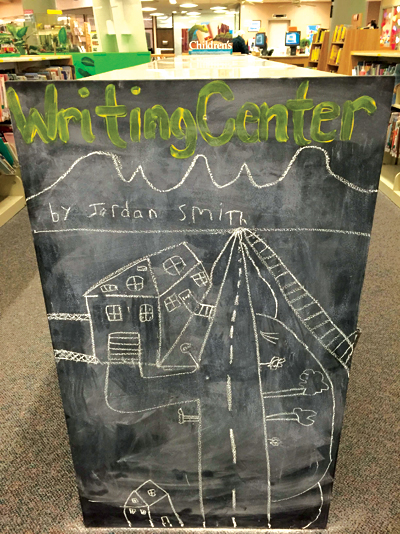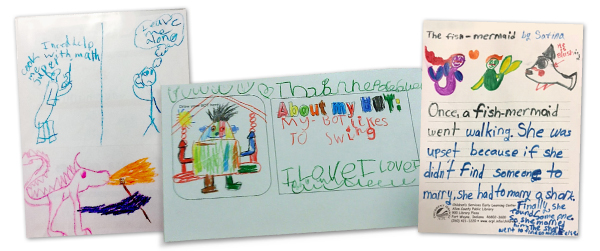Scribble: How to Grow Budding Writers

Illustration by Miguel Davilla
Public libraries and writing have a long and storied history. We run creative writing workshops for kids and adults alike. But what about emergent writers? What are we doing for those tiny tots with rapidly expanding minds…and crayons in their hands, about to scribble all over their favorite pages in Brown Bear, Brown Bear What Do You See? Let’s be real. Sometimes we have a love/hate relationship with early writing in libraries, for obvious reasons.
But libraries are a place for all. We need to recognize that “scribbling is to writing what babbling is to speaking: an early stage of children’s development that should be encouraged,” said educational consultant Janice J. Beaty. We also need to realize that a scribbled-on page is the same as a scratched DVD: a cost of doing business. In fact, I would argue that the price of missed opportunities is higher, and more difficult to replace, than a picture book.
Fortunately, many public libraries are providing rich early-learning writing experiences with not only paper and pencil, but with chunky crayons, water, paintbrushes, and even a generous dollop of shaving cream.
Predictable stages
In an article titled “Learning to Write and Draw” on the Zero to Three website, the four stages of drawing and writing that young children experience are outlined as follows:
1. Random scribbling 2. Controlled scribbling 3. Lines and patterns 4. Pictures of objects or people
Therefore, before a child can progress to drawing straight or curved lines, they need plenty of practice in the art of scribbling. They also need to learn how to hold writing implements. Those chunky crayons are far easier to grasp in a fist than a thin crayon, or a pencil, between two fingers as they develop their fine-motor skills. At Mount Prospect (IL) Public Library, assistant head of youth services Dana Folkerts will remind caregivers that when toddlers try to pick up the bubbles from the floor, they are working on their pincer grasp. This strengthens their finger and hand muscles, which they’ll need when they start to learn to write. “Something as simple as bubble play is getting them ready for writing and reading!” says Folkerts.
Early writing practice
Kary Henry, the preschool outreach coordinator at the Deerfield (IL) Public Library, will often have children practice early writing. “I have individual white boards and hand out markers so that children can write or draw, typically a response to a book we’ve just read. We also do finger plays that strengthen hand muscles. Another activity is circling items on newspaper flyers for our grocery lists during a food-themed storytime.”
This early writing practice is something that Laura Dinehart, an assistant professor of early childhood education at Florida International University, realized was crucial to future school success. Through a study conducted in 2012 in the Miami-Dade School District, Dinehart found that “preschoolers’ early writing skills did predict both their grades and standardized test scores in second grade reading and math.” This unexpected finding gives strength to the idea that early learning opportunities in public libraries are as educational as those conducted in formal school settings.

A little chalkboard paint works magic at Thomas Branigan Memorial Library in Las Cruces, NM.
Photo courtesy Thomas Branigan Memorial Library
The Brooklyn Public Library (BPL) is immersed in early learning, as evidenced by their First Five Years program that incorporates the best practices of Every Child Ready to Read. An entire session of the six-week Ready, Set, Kindergarten program is dedicated to writing, says Jessica Ralli, BPL’s early literacy programming coordinator. Books are chosen that show writing or drawing within the story. Street signs, subway signs, store windows, and other titles depict the world that preschoolers see. Librarians are encouraged to share messages with parents that focus on encouraging writing opportunities at home. This can be as simple as talking to children about what they draw.
Setting up stations
Some libraries, such as the Thomas Branigan Memorial Library in Las Cruces, NM, are embracing the early writing movement by providing writing stations in their children’s departments. Library manager Catherine Christmann shared how Tracee Waters, senior library assistant, came to her with the idea to paint two bookshelf end panels with chalkboard paint. “The kids love it. Young ones scribble and older kids draw pictures. Some mothers write words and have their children copy them. We have a small bucket with chalk and erasers next to each chalkboard.”
The Oakland (CA) Public Library also makes use of chalkboards and chalk, plus “an art table set up with paper, coloring sheets, and crayons. We have a small gallery on a wall next to the table where we display children’s work,” explained Helen Bloch, a librarian. Bloch offers “tips to parents during storytimes, encouraging them to write with their children using rice in a pan, bubbles in a tub.”
Play with a purpose
Shaving cream in a library? Only if it is in a sealed ziplock bag. Kathy Kleckner, children’s librarian at the Galaxie Library in Apple Valley, MN, found that children loved this sensory experience. Tots used cotton swabs or their fingers to trace lines, letters, and shapes into the shaving cream tinted with food-coloring.
While play/writing activities don’t need to eat up a lot of real estate, as at Galaxie, other libraries are expanding to include play zones. The Allen County (IN) Public Library is home to an approximately 2,200-square-foot space, devoted to early literacy and pre-numeracy skills. This room is designed to be used by children age six and younger with their adults for “learning play,” said children’s services manager Mary C. Voors. “We have several writing stations for kids to practice fine motor and writing skills, along with creative play centers, story nooks for shared reading experiences, and more.”
The San Jose (CA) Public Library is in the process of adding play areas at all 24 libraries. Early-education manager Madeline Walton-Hadlock shared that 10 locations now have play areas with writing centers that can include crayons, pencils, paper, envelopes, postal boxes, or magnetic writing boards that are out at all times to encourage early writing.

A toddler tackles a fine-motor activity at the Play and Learn Center at Springfield-Greene County (MO) Library District.
Photo courtesy Springfield-Greene County Library District
Leveraging outreach services
Early literacy tips and practices around writing can also be shared via outreach services. Stephanie Smallwood, early learning specialist at the Springfield-Greene County (MO) Library District, talks with caregivers about the important benefits of early writing. “Many families feel [that] they have to teach their children to write, so it is a great opportunity to explain how writing actually develops and to share activities that will help.” Smallwood conducts outreach programs, including storytimes, and works with families one-on-one at a local Women, Infants, and Children (WIC) office, where she tries to adapt her writing advocacy to each situation. “In a storytime, that might involve large-motor activities while mentioning that strong bodies are needed for reading and writing. Even with babies, I try to give them floor and tummy time and talk about how hard muscles are working to grow.” Smallwood reports that the families at WIC often ask about writing and motor skills. “We usually talk about the connection that gross- and fine-motor activities have to writing, or I encourage parents to allow free writing and drawing, and gently discourage them from forcing the child to write letters over and over.”

The results of the Story Action Pod program at La Crosse (WI) Public Library.
Children’s projects courtesy of brycedontplay.blogspot.com
A seamless storytime integration
Incorporating writing into storytime without it becoming didactic can be tricky, but Bryce Kozla, a youth services librarian at Washington County (OR) Cooperative Library, found a way: her Story Action Pod program. At first, it was just an extension of preschool storytime, using a book read that week and a writing prompt. “But after I stopped presenting the original storytime, the extension just carried on,” recalls Kozla, who started the program while she was a librarian at the La Crosse (WI) Public Library.
Older kids soon started showing up, so Kozla came up with a way to keep them coming back. She would prompt them to create a story based on a perennial favorite: If You Give a Mouse a Cookie by Laura Numeroff. Kozla asked kids to imagine what would happen if you gave something to a dinosaur? He would call you way too often if you gave him a phone, if the resulting drawing (above left) were any indication. What if you gave a dinosaur a marshmallow? S’mores galore, obviously!
In a recent online article on The Conversation, child development experts Rebecca Treiman and Lori Markson asserted that “young children know more about writing than we might think. There is more to their scribbles than meets the eye.”
I have my own vivid memories of what looked like a jumble of exuberant scribbling to me, created by my then three-year-old. “Can you tell me something about this picture?” I asked. My child talked for 20 minutes, deciphering it with his own language and storytelling skills. Ask that question! You’ll likely be amazed at the creative answers you get.
RELATED
The job outlook in 2030: Librarians will be in demand
The job outlook in 2030: Librarians will be in demand
ALREADY A SUBSCRIBER? LOG IN
We are currently offering this content for free. Sign up now to activate your personal profile, where you can save articles for future viewing






Add Comment :-
Comment Policy:
Comment should not be empty !!!
lisa kropp
Thanks Chris! I love writing articles that let me learn from great colleagues around the country! So many effective, and easy little tweaks to make to introduce writing to the younger set! LisaPosted : May 23, 2016 09:58
Chris Gifford
this article has given me so many great ideas! White boards with writing prompts for adults. A toddler table with a white board top, you could even do the shaving cream on it. It would clean up so easy! Menu planning story time for kids and the grocery ads and so many more..... Thanks!Posted : May 13, 2016 08:08